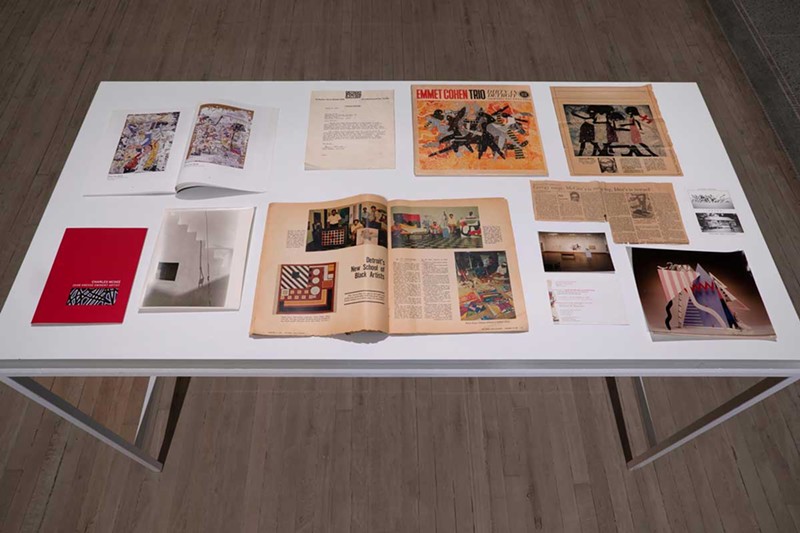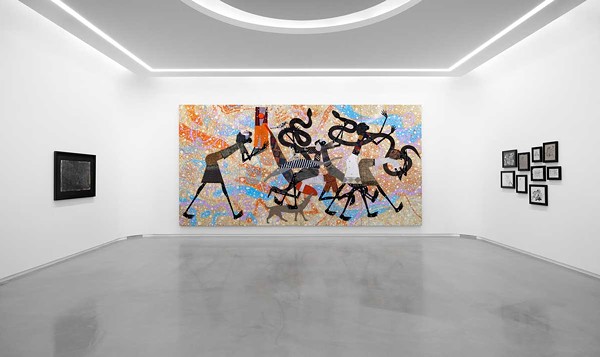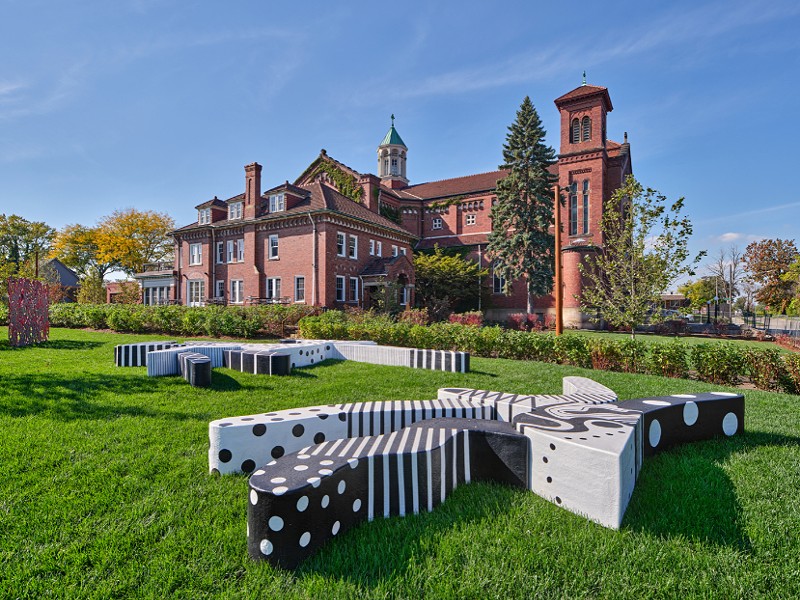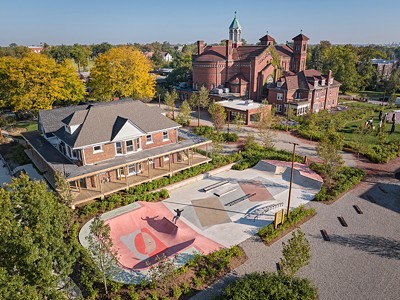Library Street Collective’s Little Village campus opened over the weekend, and at the center of it all was Charles McGee.
The late Detroit artist, who blessed us with abstract and figurative paintings, sculptures, and public installations, passed away in 2021 but the time for his legacy is now. Little Village is anchored by an exhibition and event space in a former church dubbed The Shepherd. For its inaugural exhibit, Library Street Collective partnered with the Museum of Contemporary Art Detroit (MOCAD) to present a survey of McGee’s work at The Shepherd called Charles McGee: Time is Now. It features a range of McGee’s sculptures, paintings, archival materials, and drawings, many of which have never been shown before.
Tucked into the East Village neighborhood, the former Good Shepherd Church where Library Street Collective has set up its newest gallery feels like a container for both past and present with many historic elements preserved and reimagined.
McGee speaks to visitors when they first enter the space through a display of his Kresge Eminent Artist video from 2008 and Mike Ellis’s short film on him from 2006.
Stained glass windows of saints line the walls of the dimly-lit church while a room of stark white seems to shine from the inside out. This is the first part of the gallery where visitors will find Time is Now.
Mixed media paintings are displayed here alongside one of McGee’s most recognizable pieces, “Play Patterns II.” Seeing it up close reveals a combination of textures, colors, and movement that feel musical as the serpents and human figures in the piece seem to dance around each other. In the same room are early concept sketches for the figures that would come to appear in his larger works.

PD Rearick, courtesy of the Charles McGee Estate and Library Street Collective
Charles McGee: Time is Now. It features a range of McGee’s sculptures, paintings, archival materials, and drawings, many of which have never been shown before.
“So rarely do we get to peer inside the early stages of a work. And so, although the famous gigantic piece anchors the show, for us curatorially, it’s these works that have influenced the entire thing,” says MOCAD Artistic Director Jova Lynne, who curated the exhibit.
She adds, “I never like to call an artist a godfather of anything, but I will say, this is an exceptional artist who did a lot around abstraction, figurative work, and sort of thinking about Black artists across the city, impacting his total practice as both an artist and a curator.”
Time is Now is separated into three rooms, marking the evolution of McGee’s work across his six-decade career. The first room showcases the layers of his art practice, the second serves as an archive, and finally, he is positioned as a contemporary American artist in the third, Lynne explains.
“I think there’s a lot of time when we talk about Black artists as though we’re not American,” she says. “The evolution of this artist’s work is really something that I think framed the contemporary art scene.”
MOCAD Assistant Curator Abel González Fernández echoes Lynne’s thoughts.
“He went through a lot of creative chapters in his work,” he says about McGee. “He started in the early 1960s with impressionist work after he graduated from the school that is now [the College for Creative Studies]… But then he traveled to Europe, he came back, [and] he opened a gallery to foster and champion Black abstractionists from the ’60s to ’79. And then he consolidated his style that we’re seeing right now in this piece, ‘Play Patterns’ in the ’80s that is in dialogue with his [‘Noah’s Ark: Genesis’] piece that is at the [Detroit Institute of Arts].”
The archival section includes a Detroit News article from 1979 when McGee founded the Detroit New School for Black Artists along with Gallery 7, which he ran from 1969 to 1979 focusing on Black artists. A copy of the Emmet Cohen Trio’s 2019 album Dirty in Detroit on vinyl, for which McGee did the cover art, is also displayed in the archive. The MOCAD crew gathered a lot of the materials here from McGee’s daughters.
“There’s a term that I’ve learned recently, which is ‘camouflage classrooms,’” Lynne says. “And camouflage classrooms have this idea that you don’t have to be institutionally taught to be an artist. You don’t have to be a part of certain structures in order to be successful. And I think the wonderful thing about Gallery 7 is that it was like a camouflage school, but also really a place that fostered artists at a time when other galleries were not showing Black artists, even considering Detroit’s very Black population.”
Time is Now is up until July 20 but the Charles McGee Legacy Park just outside The Shepherd, showing his first figurative work in public sculpture, is permanent. The outdoor sculptures are the last thing McGee worked on with Library Street Collective founders Anthony and JJ Curis before his passing.
A companion show to Time is Now called Kinship: The Legacy of Gallery 7 will run at MOCAD from June 28 to September 23. While Time is Now focuses on McGee’s work, the MOCAD exhibit is a group show highlighting the legacy of McGee’s Gallery 7 and his way of bringing artists together. Kinship will feature work by Lester Johnson, Gilda Snowden, Allie McGhee, Charles McGee, Harold Neal, Robert Stull, Elizabeth Youngblood, and Naomi Dickerson.


